CES 2015: Wearable tech becomes invisible
- Published

The creator of a smart insole says wearable tech does not need to have its own display or buttons
Wearable tech is staging a vanishing act.
That's not to say that there you can't find any new products here at CES in Las Vegas.
In fact, the show floor is packed with me-too fitness tracking bracelets, cut-price touchscreen smartwatches and strap-on heart rate monitors.
But a select number of exhibitors is attempting to sell products that do not flag the fact the wearer is sporting a gadget.
AmpStrip is a case in point. The heart rate and activity tracker is designed to be stuck to the wearer's torso like a plaster and left there for seven days at a time, hidden from view.
"Once you're done and want to remove it, you can peel it off like a Band-Aid, [and then recharge it], put another adhesive on it and put it back on," explains Dave Monahan, chief executive of its maker FitLinxx.
"I truly believe we are not going to win the wearables war or be successful unless the product is invisible and kind of fades into your life.
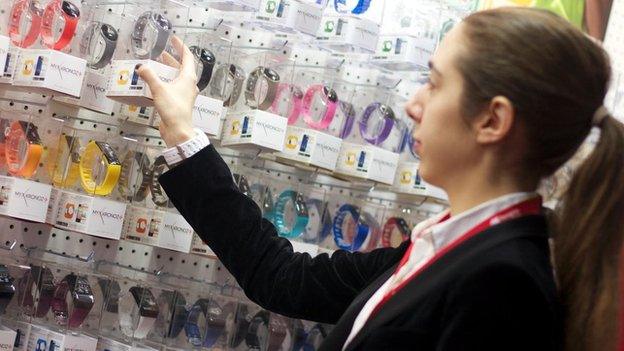
CES's show floor is awash with new budget-priced fitness trackers
"Our use case is an athlete trying to train for an event, and they want 24/7 information but not something that's going to get in the way."
The Lechal haptic inner soles are another example. Made by an Indian start-up, the kit links up to a smartphone via Bluetooth and vibrates under the wearer's feet to provide notifications.
These include fitness-related alerts - triggered, for example, when an internet-paired rival runs faster - or directions, by buzzing the relevant foot.
"Today, when you go to buy a pair of shoes there is already technology in them - the way they were constructed, the materials used for shock absorption, all of that," says Krispian Lawrence, co-founder of Ducere Technologies.
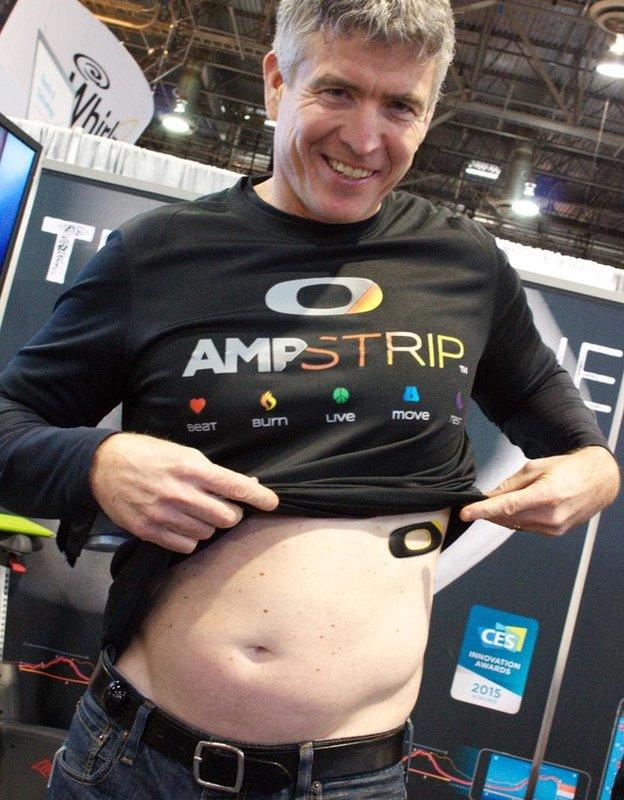
The AmpStrip has raised more than double its $50,000 goal on a crowdfunding site
"But when you buy them, what's going through your mind is how do they look, how comfortable are they.
"I think this is the future of technology.
"I feel wearable technology should integrate into a user's life without the hassle of it being a device. And you can only do that when technology and fashion merge."
Smart clothes
Others are working on similar concepts.
Both the UK's Cambridge Consultants and France's Cityzen Sciences are showing off prototype smart shirts which have a range of sensors integrated into the fabric.
Leo Kelion speaks to Cityzen Sciences
And an Australian start-up has just put on sale GameTraka, a GPS-enabled device that sits behind the wearer's neck in a kind of bra shape to provide performance data from contact sports such as rugby and basketball.
"I'm not a fan of wearing wearables - the only thing I want you to see is my watch and not lots of gadgets all over me, and I think many people are the same," says its manufacturer William Strange.
"Just because you want data, doesn't mean you want the device gathering it to be seen."
One industry-watcher suggests we are seeing the start of a new trend, but adds that it would be premature to predict the end of visible wearables.
"In the long run we will get used to having sensors in our clothing, and in our life all around us, transmitting data," says Weston Henderek, who covers the sector for research firm NPD.

Mr Strange says it would be hard to notice his firm's tracker when it is being worn
"But I think people will also want smartwatches as well as some kind of worn fitness trackers.
"Some functionality might get shifted over to shoes, gloves or what have you, but there's going to be different markets and people who own both."
He notes that a recent survey indicated the biggest market for fitness trackers in the US was now middle-aged women earning an average income of more than $100,000 (£66,100) a year.
This, he says, is driving wearable tech to become invisible in different way: remaining on display but with its origins obscured.
Smart Swarovski
At CES, activity-tracker maker Misfit has unveiled a solar-charged model that hides its tech origins behind a large purple Swarovski crystal, turning the device into a piece of jewellery.
"Our thinking is can we make something that is both beautiful and functional that people will want to wear," says Lindsay Kresch, Misfit's director of corporate partnerships.
"The fact is we're running out of wrist space. When you buy a nice watch you don't want to take that investment off your wrist. [And] I think people want more discreet ways to monitor their fitness."
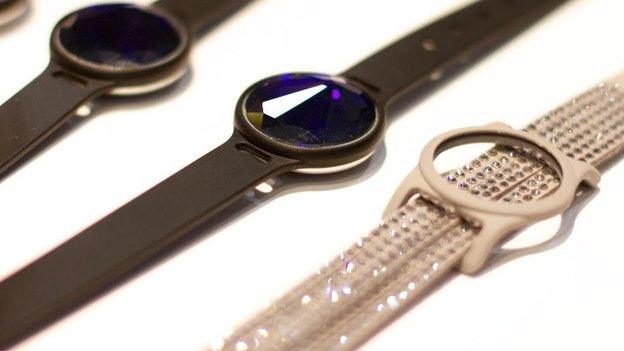
The purple crystal helps hide the solar panels used by Misfit's latest activity tracker
The sector's bestselling player is Fitbit. The vast majority of its products still retain digital readouts and a plasticky look. But it too is experimenting with fashion by partnering with designer Tory Burch, who has created a range of gold and silver bracelets and pendants that hide away the tech firm's tracker component.
"Some people really want to show off their commitment to fitness and show off they are wearing a device," says Lindsay Cook, Fitbit's marketing director.
"But we realised there are some people who want to wear the products in new ways, for instance they want to take it to a fancy dinner or wedding - for those folks especially women, we found they wanted these new formats."
Mr Henderek notes that such fashion tie-ups also help tech companies remain distinctive, protecting them from budget-priced rivals who are often quick to incorporate similar sensors and functionality.
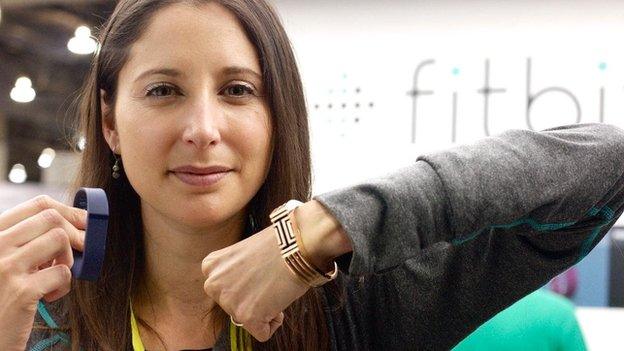
Ms Cook believes there is a market for both plastic and jewellery Fitbit kit
"You're going to see this a lot over the course of the year as the firms seek to avoid commoditisation," he notes.
"But some of these markets are going to be very niche.
"How many people are going to want to go walking around with a huge crystal in the middle of their device?"
Dawn of the smartwatch
The key tussle between visible and concealed wearable tech may be about to occur in the smartwatch sector.
Apple will soon join Samsung, LG, Motorola and others in releasing a device that runs apps on a small touchscreen.
Others are betting customers will prefer a more subtle approach.
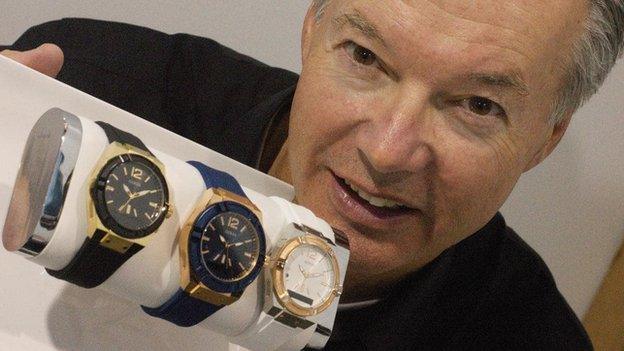
Mr Kinsey believes Martian's tie-up with fashion firm Guess will boost its fortunes
Martian - a smartwatch pioneer, whose kit accepts voice commands and displays notifications on a small readout - has opted for a look dominated by analogue watch hands. It's just unveiled new models designed and branded by fashion firm Guess.
"Apple is going to convey to the world what a smartwatch can do," says Martian's president Stanley Kinsey.
"But we've taken a different view. There's going to be some percentage of people who want the Apple look, but many that want the look that we've got."
In truth, few think that Martian will achieve anything like the sales of the Apple Watch, despite the benefit of Guess's brand.
But others might.
Watch-giant Fossil has announced its intention to launch a wide range of tech-enhanced wearables after forming a partnership with Intel. The first models will go on sale later this year. Some will be touchscreen smartwatches powered by Android Wear, but others will be more traditional looking watches and other forms of jewellery that have their sensors and computing functions hidden away.
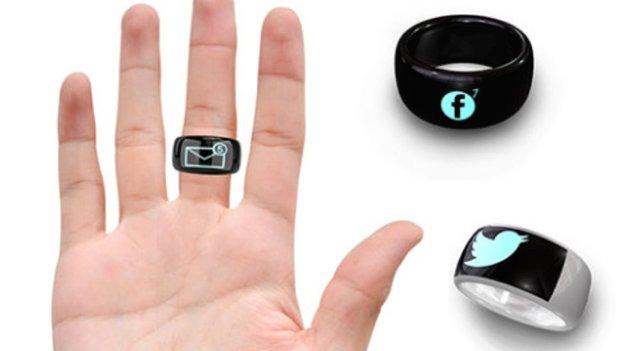
The Bluetooth-connected Mota ring is still at the concept stage
"We're not in a race to bring a smartwatch to market," the firm's chief strategy officer Greg McKelvey tells the BBC.
"We are in a race to bring connected accessories that our fashion customers actually want and desire, that happen to have technology that allows more functionality than just timekeeping. There will be no compromise on style."
Swiss firm Tag Heuer is also reported to be preparing a range of traditional-looking smartwatches, although rumours it would show off some early models at CES proved false.
Even if the fate of wearable tech is that much of it will be hidden away, there are always likely to be those who remain committed to putting digital displays centre-forward.
The most striking example at this year's CES is arguably Mota, a "smart ring" that displays Twitter and Facebook updates on your finger.
"People want to be in the in. They want to let people know they are into electronics and the new future, and what other way is there to do that than showing off a product that is full of technology?" says operations manager Erica Henson, somewhat optimistically.
With some experts forcecasting the wearable tech market could generate as much as $70bn of sales a year within a decade, there's an awful lot riding on manufacturers picking the right look.
Click here for more coverage from the BBC at CES 2015, external
- Published7 January 2015
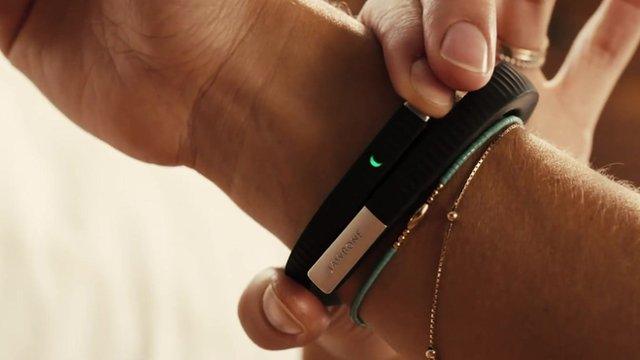
- Published18 December 2014

- Published17 December 2014
